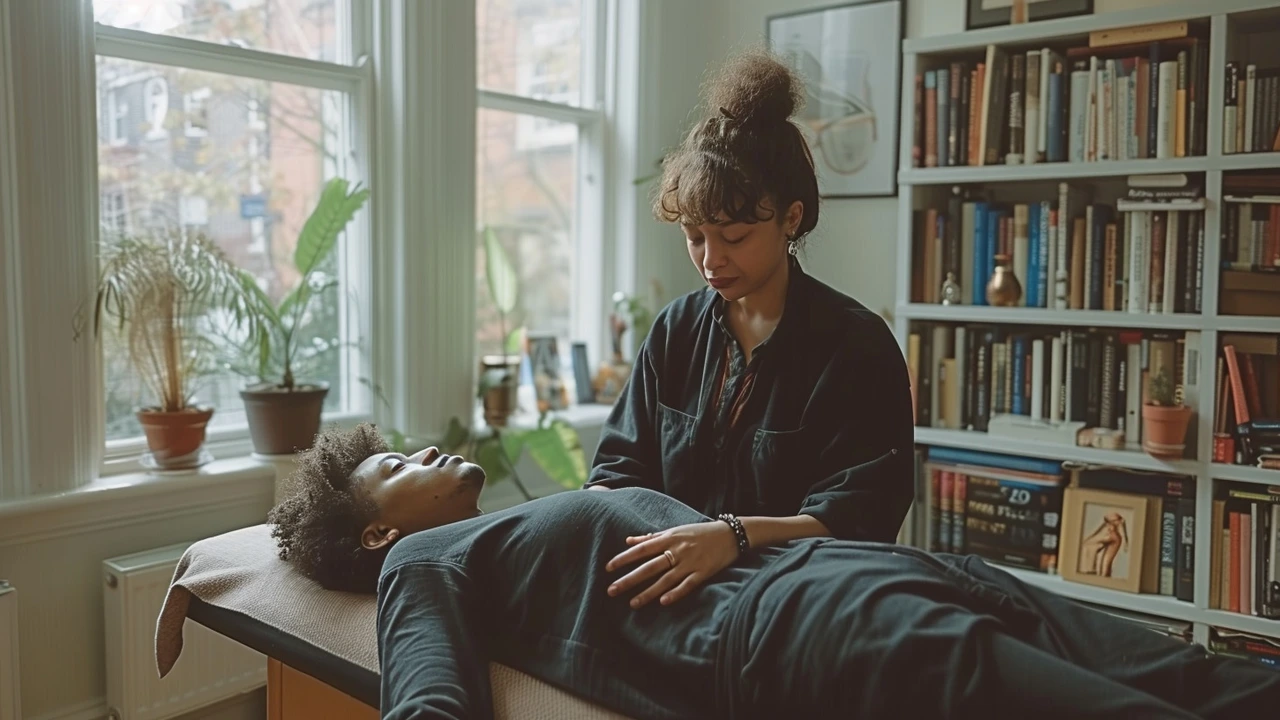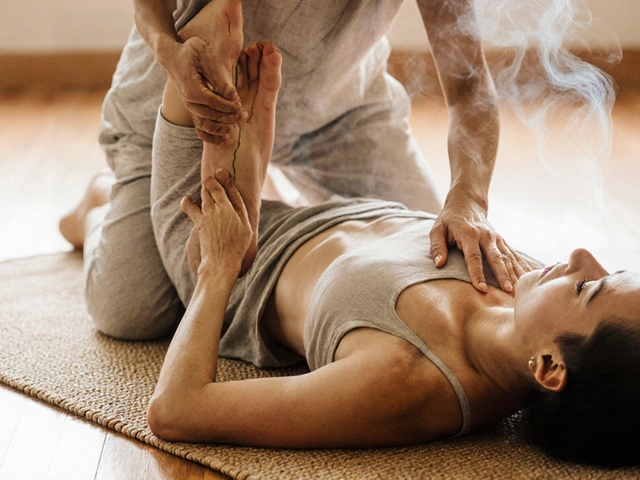Rolfing Therapy: Traditional Techniques for Modern Health

Rolfing therapy is becoming a buzzword in the wellness industry, but what exactly is it? In simple terms, Rolfing is a specialized form of bodywork that aims to realign the body's structure through deep tissue manipulation. By focusing on the fascia—the connective tissue that surrounds muscles—Rolfing seeks to improve posture, relieve chronic pain, and enhance overall well-being.
Though it sounds modern, Rolfing has roots dating back to the mid-20th century. Named after its creator, Dr. Ida Rolf, this therapy has helped countless individuals find relief from physical and emotional stress. With a growing number of people seeking holistic health solutions, Rolfing offers a fascinating and effective option.
- The Origins of Rolfing
- Understanding the Rolfing Process
- The Benefits of Rolfing
- What to Expect in a Rolfing Session
- Rolfing vs. Other Therapies
- Tips for Integrating Rolfing into Your Life
The Origins of Rolfing
The story of Rolfing begins with the pioneering efforts of Dr. Ida Rolf, a biochemist by training who was fascinated with the human body's potential for self-healing. Born in 1896, Dr. Rolf spent much of her professional life exploring various disciplines, from biology to yoga, seeking ways to improve human well-being. Her relentless curiosity led her to develop a unique system of bodywork that eventually became known as Rolfing.
In the 1940s and 50s, Dr. Rolf started to form her theories around the idea that a person's health could be drastically improved by addressing the body's structural alignment. She theorized that the body's connective tissues, or fascia, often became misaligned due to injury, stress, or poor posture. These misalignments could then lead to chronic pain and other health issues. Using deep manual therapy techniques, Dr. Rolf believed that practitioners could realign the body's tissues to restore a natural, balanced posture and improve overall function.
Dr. Rolf initially tested her theories on friends and family, seeing remarkable improvements. Word of her success spread, and she soon began teaching her techniques to others, paving the way for the formalization of Rolfing as a therapeutic practice. In 1971, she founded the Rolf Institute of Structural Integration in Boulder, Colorado, which remains a leading institution for training Rolfing practitioners to this day.
“The body is a plastic medium that can be shaped and changed,” Dr. Rolf said, encapsulating her belief in the transformative power of Rolfing. “We can indeed change our structure, but changes must be made at a deep level.”
Rolfing gained traction in the 1970s and 80s, especially among athletes, dancers, and individuals seeking alternative therapies. Its emphasis on holistic health and the interconnectedness of body and mind resonated with those searching for more than just temporary relief from pain. Early adopters reported not only physical benefits but also emotional and psychological improvements.
Over the decades, research has continued to validate many of Dr. Rolf's claims. Studies have shown that Rolfing can help with chronic pain, increase range of motion, and even improve respiratory function. By addressing the root causes of misalignment, Rolfing offers a comprehensive approach to health that appeals to many struggling with modern, sedentary lifestyles.
Today, Rolfing boasts a global community of practitioners, all dedicated to advancing Dr. Rolf's vision. The practice remains rooted in her original principles while also incorporating modern scientific understanding. This blend of tradition and innovation keeps Rolfing relevant as a health solution for the modern era.
Understanding the Rolfing Process
Diving into the world of Rolfing can feel like a journey into an uncharted territory of holistic health. The Rolfing process is meticulously designed to remodel the body's fascia, which is the connective tissue surrounding muscles and organs. This is accomplished through a series of sessions, usually around ten, each with specific goals aimed at improving different aspects of body alignment and function.
The first few sessions are typically focused on freeing up the surface layers of fascia and working on overall alignment. This might involve lengthening and opening the body’s front, back, and sides. As the sessions progress, the focus shifts to deeper layers of tissue. By the final sessions, the Rolfing practitioner is often working to integrate the changes made throughout the process, aiming to enhance the body's movement and posture substantially.
One key aspect of Rolfing is its attention to posture and balance. Dr. Ida Rolf believed that gravity plays a crucial role in personal health. She posited that a body properly aligned with gravity could move more efficiently and with less pain. Rolfing practitioners are trained to see and feel subtle misalignments in the body and use their hands to apply firm pressure and manipulate the fascia, coaxing the body back into balance.
Rolfing is not a one-size-fits-all treatment. Each session is customized to the individual's needs and responses to previous treatments. It's a highly interactive process where the practitioner might ask the client to breathe deeply, make small movements, or even stand up and walk to assess changes in alignment and functionality. This feedback loop ensures that the therapy adapts to the client’s evolving condition.
“You may not understand the science behind it, but you don't need to,” says John Smith, a certified Advanced Rolfer with over 20 years of experience. “What you will notice are tangible changes— improved posture, better range of motion, and a reduction in chronic pain.”
Physical pain isn't the only focus of Rolfing. Many clients report emotional and psychological benefits as well. The fascia is deeply connected to our nervous system, and releasing tension in this tissue can sometimes evoke emotional responses. This makes Rolfing a holistic treatment addressing both mind and body. Often, clients feel a sense of lightness or emotional relief as the sessions progress.
Every session aims to build upon the previous one, creating a cumulative effect. The pacing and intensity of sessions can vary depending on the client's needs, their individual responses to treatment, and even their emotional readiness for the changes. This dynamic nature makes Rolfing a unique and highly personalized form of therapy. If you're considering Rolfing, it is often recommended to commit to the full series of sessions to achieve the maximum benefits.

The Benefits of Rolfing
Rolfing therapy holds numerous benefits that can drastically improve one’s quality of life. One of the primary advantages is better body alignment. When the fascia becomes tight or misaligned due to poor posture, injury, or stress, it can lead to chronic discomfort. By applying pressure to these areas, Rolfing can effectively loosen the fascia, allowing the body to return to its natural and balanced state. Improved alignment not only reduces pain but also enhances overall mobility, making everyday movements smoother and less taxing.
Another significant benefit of Rolfing is pain relief. Many individuals suffer from persistent aches, whether from old injuries, long hours at a desk, or stress. Unlike traditional massage that primarily focuses on surface muscles, Rolfing targets the root cause of the pain by working with deeper layers of tissue. This makes it especially beneficial for those with chronic pain conditions. A study published in the 'Journal of Alternative and Complementary Medicine' showed that participants reported a considerable decrease in pain levels after just a few sessions of Rolfing.
Rolfing also promotes better emotional well-being. Our bodies and minds are interconnected, and physical tension often correlates with emotional stress. As practitioners manipulate the fascia, it can release stored emotions, leading to a sense of emotional relief. Many people report feeling lighter and more at ease, both physically and mentally, after a session. According to Dr. Rolf, “When the body gets working appropriately, the force of gravity can flow through. Then, spontaneously, the body heals itself.”
Improved breathing is another fantastic benefit. Our respiration relies heavily on the alignment and flexibility of our ribcage and diaphragm. Tight fascia can restrict these areas, leading to shallow breathing. By addressing these restrictions, Rolfing can enhance respiratory function. Better breathing means more oxygen, which in turn boosts energy levels and overall vitality. People frequently notice they breathe more deeply and effortlessly following their sessions.
For athletes and fitness enthusiasts, Rolfing offers enhanced performance and recovery. Optimal muscle function and alignment are crucial for peak performance and quicker recovery. By ensuring that muscles and joints are in the best possible condition, Rolfing helps athletes achieve their goals and recuperate faster after intense activities. Testimonials from professional athletes often highlight the profound impact of Rolfing on their careers.
Lastly, Rolfing encourages better postural habits. Modern lifestyles often contribute to poor posture, whether from prolonged sitting, screen time, or repetitive motions. Over time, these habits can lead to structural imbalances. Rolfing not only addresses these imbalances but also educates clients on how to maintain proper posture in their daily lives. This awareness helps prevent the recurrence of issues, fostering long-term health and wellness.
What to Expect in a Rolfing Session
Stepping into your first Rolfing session can be a mix of curiosity and excitement. Often held in a serene and comfortable environment, the session usually begins with an initial assessment. The Rolfer—your therapist—will ask about your health history and specific concerns you want to address. Don't be surprised if they take a close look at your posture while you stand, walk, and move around. This helps them identify any misalignments or imbalances in your body.
The actual hands-on work is where Rolfing truly stands out. Unlike a typical massage that focuses on relaxation, Rolfing involves deep, targeted pressure aimed at the fascia. This can be described as both a relieving and intense experience. The Rolfer uses their fingers, knuckles, and elbows to manipulate the connective tissues, helping to release tension and improve alignment. Sessions generally last between 60 to 90 minutes, and you may be asked to perform simple movements to aid the process.
It's important to communicate openly with your Rolfer throughout the session. If any technique feels too uncomfortable, let them know. Rolfing should never be unbearably painful, and adjustments can always be made to ensure your comfort. Some people might feel sore afterward, similar to how you'd feel after a rigorous workout. This is normal and usually subsides within a day or two, leaving you feeling more balanced and aligned.
According to the Rolf Institute of Structural Integration, "More than just a technique for muscular relaxation, Rolfing focuses on creating order and balance through a series of sessions." This encapsulates the unique philosophy behind this therapy, making it more than just another wellness trend.
A standard Rolfing series typically consists of ten sessions, each with its specific goals. Known as the Ten Series, the first three sessions focus on superficial layers of tissue, while sessions four through seven dive deeper. The final three sessions work to integrate these changes and promote overall balance. This structured approach ensures comprehensive body alignment and lasting results.
Setting realistic expectations is key. While some people experience immediate relief, others might notice gradual improvements over several sessions. Regular Rolfing can lead to long-term benefits such as enhanced flexibility, better posture, and reduced chronic pain. It's also worth mentioning that Rolfing isn't just for those with physical ailments; many athletes and performers use it to optimize their performance and prevent injuries.
If you're considering adding Rolfing to your wellness routine, here are some tips: Wear comfortable clothing to your sessions, stay hydrated, and consider keeping a journal to track your progress and any changes you notice. By doing so, you'll maximize the benefits and gain a deeper understanding of your body's needs.

Rolfing vs. Other Therapies
When comparing Rolfing to other forms of bodywork and therapy, it’s essential to understand the unique aspects it brings to the table. Traditional therapies like massage and chiropractic care focus on specific areas or symptoms. Rolfing, however, addresses the body as an integrated whole.
Massage therapy usually aims to relax muscles, reduce tension, and promote general well-being. It is an excellent way to relieve temporary aches or stress. However, the results may not be as enduring. On the other hand, Rolfing looks at long-term structural changes. By manipulating the fascia, it seeks to realign the entire body, leading to more lasting results.
Chiropractic care focuses primarily on spinal alignment. Chiropractors use adjustments to correct misalignments known as subluxations. While these adjustments can provide relief, they tend to focus more on acute issues and are often centered around the spine alone. Rolfing goes beyond, addressing every layer of fascial tissue across the body. This method often leads to a more balanced and symmetrical body alignment.
Acupuncture is another alternative therapy people often consider. It involves inserting needles into specific points on the body to stimulate healing and relieve pain. While acupuncture has its merits, it primarily deals with energy flow (known as qi) and symptom relief. Rolfing delves into the physical structure and changes how the body holds itself over time.
According to Dr. Ida Rolf, “We are not necessarily talking about the human body as a mechanical object. Instead, we look at the body as a spatial arrangement that must operate within the gravity field.” This perspective shifts the focus from merely alleviating pain to re-educating the body's posture and movement.
Physical therapy is perhaps the closest to Rolfing in terms of objective. Physical therapists develop exercises and routines to rehabilitate and strengthen specific body parts. While effective, physical therapy often lacks the holistic approach inherent in Rolfing. Rolfers aim to recondition the entire body’s connective tissues, leading to improved overall function.
In simple terms, while these therapies each have benefits, Rolfing's unique focus on the fascia sets it apart. It treats the body as an interconnected system, aiming for profound and lasting transformation. If you've tried different therapies and still struggle with chronic pain or posture issues, Rolfing might offer the holistic solution you need.
Tips for Integrating Rolfing into Your Life
Integrating Rolfing therapy into your life can be transformative, enhancing your physical and mental well-being. To start, understanding the commitment involved is crucial. Rolfing generally consists of a series of ten sessions, often referred to as the 'Ten Series,' each building upon the last to gradually align and balance the body. It's essential to approach Rolfing with an open mind and a willingness to engage fully in the process.
One practical tip is to schedule your sessions consistently. Depending on your therapist’s recommendation, weekly or bi-weekly sessions could be ideal to maintain momentum and see cumulative benefits. Consistency helps your body adapt to the changes and prevents reverting to old patterns. Remember, the goal is long-term improvement.
Another key aspect is to communicate openly with your Rolfer. Everyone’s body reacts differently, so sharing your experiences, sensations, and any discomfort will help tailor the sessions to your needs. Effective communication ensures that the therapist can adjust techniques to focus on areas that might need extra attention.
Dr. Ida Rolf once said, "Rolfing can potentially change the course of a person's life." Open communication and trust can make this journey even more rewarding.
A supportive lifestyle will complement your Rolfing sessions. This includes a balanced diet, regular exercise, and sufficient sleep. Activities enhancing body awareness, such as yoga, tai chi, or Pilates, can further the benefits of Rolfing. These practices encourage mindfulness and help maintain the new alignment achieved through Rolfing.
It's also beneficial to integrate simple stretching exercises between your Rolfing sessions. Stretching not only helps maintain flexibility but also supports the work done during each Rolfing session. Your Rolfer can recommend specific stretches tailored to your body's needs.
Financial planning is another aspect to consider. Rolfing can be an investment in your health, and it's worth budgeting for the full series of sessions. Some therapists offer package deals, which can be more economical than paying per session.
Tracking your progress can be motivating. Keep a journal or take photos to document changes in posture, movement, and pain levels. Progress can sometimes be subtle, so having a record can highlight the improvements, reinforcing your commitment to the therapy.
Lastly, share your experiences with others. As you notice positive changes, talking about them can inspire friends and family to explore Rolfing themselves. Sharing not only reinforces your learnings but could also be a starting point for a supportive community interested in holistic health.





